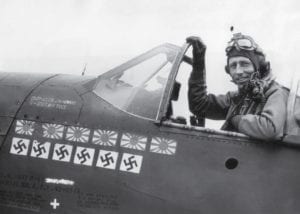
James H. Howard flying his P-51 Mustang during World War II. (United States Air Force History photo)
On January 11, 1944, the 401st Bomb Group were returning to their home base from bombing Messerschmidt production plants in Northern Germany with their B-17s, when they found themselves under fire from more than 30 Luftwaffe fighters. Having already suffered heavy losses during the mission with four aircraft lost in action, the bomb group’s hope for defense rested in a single fighter: P-51 aeronaut James H. Howard.
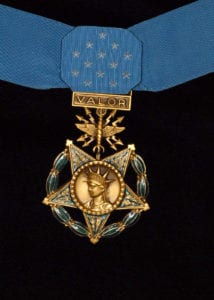
Medal of Honor (United States Air Force History photo by Mr. Steve White)
Instead of waiting for his fighter group to reassemble, Howard, “with utter disregard for his own safety,” stayed with the bomb group for thirty minutes and chased off the German fighters independently, a “one-man Air Force” as he came to be known. Despite losing three of his six machine guns and running low on fuel, Howard destroyed three enemy fighters and damaged several more before returning to his home base in England. This act of heroism earned Howard the Medal of Honor. He was the only fighter aviator in the European Theatre of Operations to receive this distinguished award.
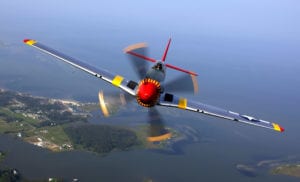
P-51 Mustang flies over Langley Air Force Base, Va. (United States Air Force History photo by Tech. Sgt. Ben Bloker)
The P-51: A Fighter Pilot’s Dream
Colonel Howard called the P-51D Mustang “a fighter pilot’s dream.”[1] The Mustang was a long-range, single-seat fighter/fighter-bomber aircraft built by North American Aviation. Pilots loved to take wing it because it was faster, agile, more maneuverable, and had a longer combat range than other World War II fighters. The Mustang is one of the most famous propeller-driven fighters of World War II and was also one of the few aircraft conceived during the war to see large-scale service.
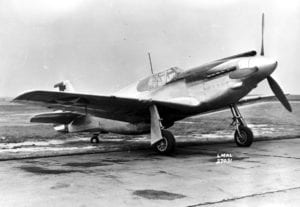
XP-51 41-039, a Mustang prototype, tested by the U.S. Army Air Corps (United States Air Force Photo)
History
In 1940, Allied forces needed a more effective fighter aircraft to escort bombers to and from their targets in Germany. To address this need, the British Aircraft Purchasing Commission asked N.A. Aviation to build a variant of the Curtiss P-40 “Warhawk” under license for the Royal Air Force (RAF). The problem with this proposal, however, was that the P-40’s design went back to 1933. Rather than using an old design from another company, North American instead proposed to create a more advanced fighter using the 1100 hp Allison V-171 engine—the same used in the P-40. The RAF agreed with one stipulation: they receive their fighter in 120 days. This fighter, first known as the NA-73X prototype, first took to the air in October 1940 and was the precursor to the P-51A.
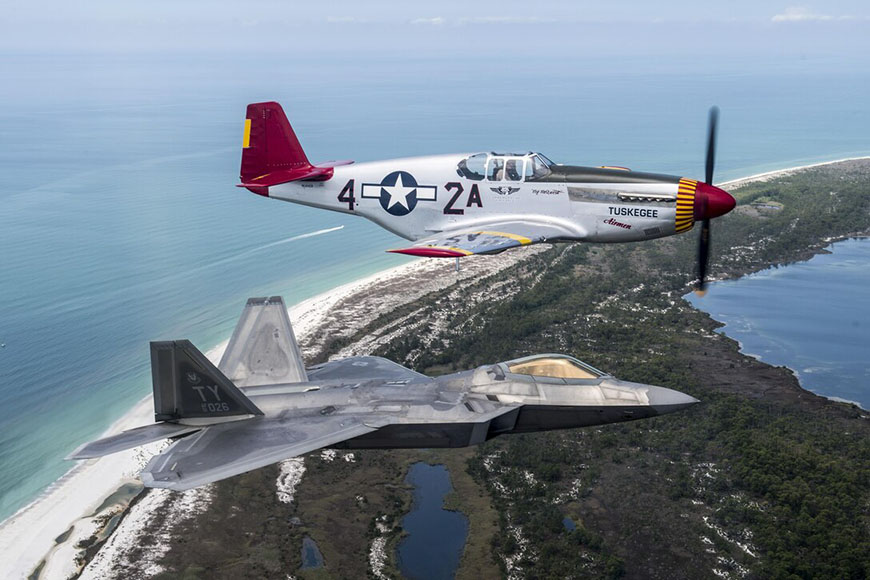
P-51A Mustang two-ship formation (United States Air Force photo)
The P-51A, given the name “Mustang” by the RAF, began combat operations in 1942. Although this early variant performed well at medium and lower elevations, its performance was limited at higher altitudes. The Allison engine’s lack of an efficient supercharger caused the P-51A to rapidly lose power above 15,000 feet. Unfortunately, above 15,000 feet was where most Allied heavy bombers had to fly. For this reason, prior to late 1943, the Mustang mostly flew as a low-altitude fighter and reconnaissance aircraft.
The Magic Merlin
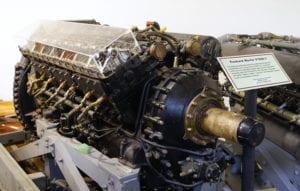
Packard Merlin V1650-7 engine, Hiller Aviation Museum. (Photo courtesy of Creative Commons.)
As World War II progressed, Allied pilots desperately needed a high-performance, long-range fighter escort to assist heavy bombers on missions against the Luftwaffe. Some RAF test pilots believed the Mustang would be better suited for air-to-air combat if it had a different engine. They wanted to test the Mustang with the 12-cylinder Rolls-Royce Merlin engine, but production of the Merlin was already slated for the British Spitfire, the Avro Lancaster, and the de Havilland Mosquito. To increase production of the Merlin, Rolls Royce contracted with Packard Motor Car Company, located in the U.S., to produce the engine under license.
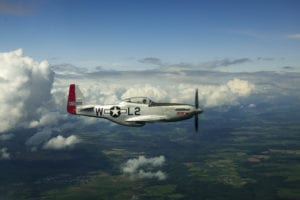
A P-51 Mustang flies over Spangdahlem Air Base. (United States Air Force photo by Master Sgt. Roidan Carlson)
The Merlin engine, with its two-stage supercharger, transformed the aircraft’s performance. Most importantly, this engine significantly improved the Mustang’s combat and training range and maximum speed. One Mustang fitted with the new engine reached 441 mph at 29,800 feet—nearly 100 mph faster than a P-51A at the same altitude. The Merlin also increased the Mustang’s service ceiling to almost 42,000 feet.
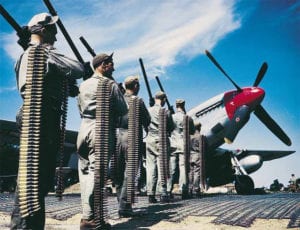
P-51 Mustang ground crew loads ammunition. (United States Air Force photo)
Turning the Tide
Before the Merlin-powered Mustang entered combat over Europe in late 1943, the Eighth Air Force suffered heavy casualties against the Luftwaffe. At the time, heavy bomber crews had to complete 25 missions before they could return home to the States, but most crews never made it past their fifth mission. It was said that to “fly in the Eighth Air Force then was like holding a ticket to a funeral—your own.”[1] During the summer of 1943, these heavy losses forced the U.S. Army Air Force (USAAF) to cancel further daylight bombing raids into Germany until the P-51D joined the fight that December. Once in place, the Mustang assumed many of the bomber escort duties previously filled by the P-38 Lighting and P-47 Thunderbolt.
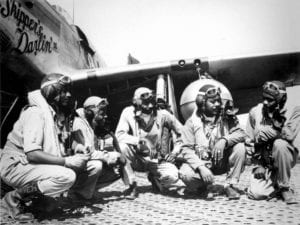
332nd Fighter Pilots, Tuskegee Airmen (United States Air Force photo)
Once the P-51D Mustang joined the Eighth Air Force, losses were greatly reduced. By February 1944, only 3.5 percent of bombers that flew against Germany were lost, compared to 9.1 percent in 1943. The P-51 was the first single-engine plane based in England with enough range to penetrate German airspace, as well as the first to reach Berlin.
Fighter Sweeps
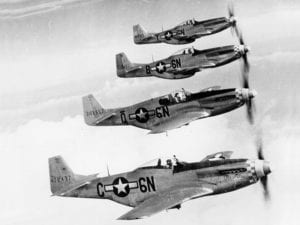
505th Fighter Squadron P-51 Mustangs (United States Air Force photo)
Not only did the Merlin-powered Mustang cut down on Eighth Air Force losses, but it also changed the way the Allies did air-to-air combat. Beginning in 1944, Major General Jimmy Doolittle ordered Mustang pilots, who had previously flown in formation with bombers, to instead fly ahead of bombers in “fighter sweeps” to intercept Luftwaffe aircraft.
In addition to this new strategy, P-51s began performing strafing ground attack missions on German airfields in February 1944, crippling the Luftwaffe and establishing Allied air superiority in Europe. By the middle of 1944, pilots had virtually eliminated the Luftwaffe as a threat.
Other Theatres
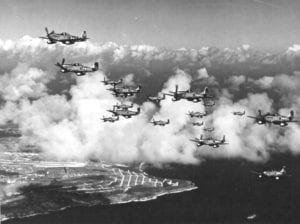
P-51 Mustang Fighter Sweep over Iwo Jima. (United States Air Force photo)
After proving its combat effectiveness in Europe, the Mustang also flew in the Pacific Theatre. Following the capture of Iwo Jima, the P-51 was a fighter escort used to join B-29s on bombing missions against the Japanese mainland. This airframe also played a major role in the China-Burma-India Theatre during the final year of the war, attacking Japanese airfields and supply routes.
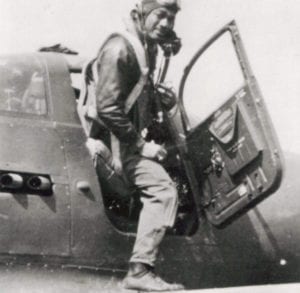
Tuskegee P-51 Mustang Pilot and Ace, Lt. Col. Lee Archer (United States Air Force Photo)
During World War II, 275 Mustang pilots achieved “Ace” status, a title given to pilots who achieved 5 or more aerial victories. Mustang pilots shot down 2,116 enemy planes, which was an average of 7.69 per Ace. By the end of war, Mustang pilots had shot down 4,950 enemy aircraft, more than any other Allied fighter.
Change of Designation
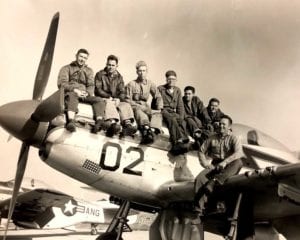
Kentucky Air National Guard P-51 Mustang (United States Air National Guard photo)
Following World War II, the Mustang’s designation changed from P-51 (for “Pursuit”) to F-51 (for “Fighter”). As the newly formed United States Air Force (USAF) began to use more advanced jet fighters, many P-51s were deemed surplus or transferred to Reserve units and the Air National Guard.
During the Korean War, however, the Mustang once again proved useful, mainly in the roles of ground attack and reconnaissance. When the United States Air Force flew into Korea from bases in Japan at the beginning of the conflict, the Mustang was especially useful in hitting targets that the short-range F-80 Shooting Star could not.
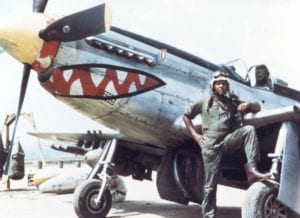
Lt. Daniel “Chappie” James Jr. stands next to a P-51 in Korea. (United States Air Force photo)
The USAF continued to use the Mustang for close base operating support and interdiction missions in Korea until replacing it with the F-86 Sabre in 1953. By the time production of the Mustang ended, more than 15,000 had been built. This airframe retired from service in 1957.
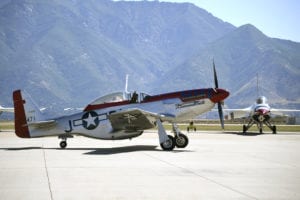
A P-51 Mustang sits on the airfield June 24, 2018, at Hill Air Force Base (Hill AFB), Utah. (United States Air Force photo by Todd Cromar)
The Mustang’s Tie to Hill Air Force Base (Hill AFB)
During World War II, the engine repair shops at Hill Air Force Base (Hill AFB) maintained and overhauled the Merlin engine until the end of the war. Hill Air Force Base (Hill AFB) also performed maintenance and repair on the Mustang itself into the 1950s.
Hill Aerospace Museum’s P-51 and Chesley Peterson
The Mustang on display at Hill Aerospace Museum is a favorite among the museum community and was built using parts from multiple P-51s and was placed on display in 1993. Its color scheme matches the Mustang flown by Utah native Colonel Chesley Peterson when he flew with the famous 4th Fighter Group during World War II, and is named “Audrey” in honor of his wife, Audrey Boyes Peterson.
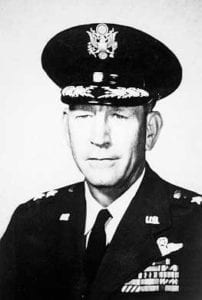
Chesley Peterson, P-51 Mustang pilot (United States Air Force photo)
Peterson joined the U.S Army Air Corps as a cadet by misrepresenting his age with a forged birth certificate. When his true age of 18 was discovered—too young for him to become a pilot—he was discharged “for lack of inherent flying ability.”
Peterson then went to England in 1940 as part of the Eagle Squadron, a group of American volunteer pilots that manned missions with the RAF against the Luftwaffe. By the age of 21, Peterson became the youngest squadron commander in the RAF and was awarded the RAF Distinguished Flying Cross.
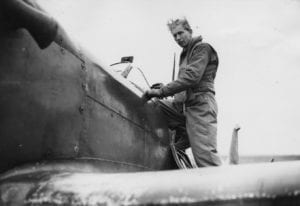
Chesley Peterson, P-51 Mustang pilot (photo courtesy of American Air Museum in Britain)
Peterson later joined the USAAF when the U.S. entered the war and went on to become an Ace, scoring at least nine enemy kills with nine probables. He was promoted to full colonel at the age of 23, the youngest in USAAF history. Peterson served as commander of the 4th Fighter Group from 1942 to 1943. The 4th Fighter Group’s main task was to provide fighter escorts for the heavy bombers of the Eighth Air Force.
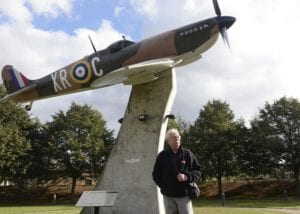
Michael Peterson, son of P-51 pilot Chesley Peterson, with replica of his father’s Spitfire at RAF Lakenheath, England. (United States Air Force photo by Airman 1st Class Abby L. Finkel)
By the end of World War II, the 4th Fighter Group had destroyed more enemy aircraft than any other fighter group in the Eighth Air Force. The serial number used for the P-51 Mustang at the Hill Aerospace Museum was originally assigned to a P-51 in the 4th Fighter Group lost during a mission over Europe in 1944.
Chesley Peterson flew a total of 130 combat sorties over the English Channel into enemy territory. He was awarded the U.S. Distinguished Service Cross, the Distinguished Flying Cross, five U.S. Air Medals, and the Purple Heart, among others. Following the war, he rose to the rank of Major General.
[1] Grant, Rebecca. “One-Man Air Force.” November 2010. Air Force Magazine, https://www.airforcemag.com/PDF/ MagazineArchive/Documents/2010/November%202010/1110oneman.pdf. Accessed 18 May, 2020.
[1] Paridon, Seth. “The Eighth Air Force vs. The Luftwaffe.” 18 October, 2017. The National WWII Museum New Orleans, https://www.nationalww2museum.org/war/articles/eighth-air-force-vs-luftwaffe. Accessed 13 May, 2020.
